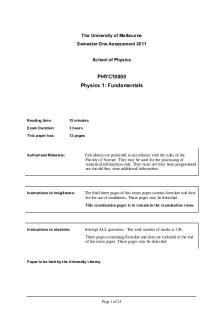Exam 1 2011, questions and answers PDF

| Title | Exam 1 2011, questions and answers |
|---|---|
| Course | Usability Engineering |
| Institution | University College Cork |
| Pages | 3 |
| File Size | 89.5 KB |
| File Type | |
| Total Downloads | 17 |
| Total Views | 165 |
Summary
OLLSCOIL NA hÉIREANN THE NATIONAL UNIVERSITY OF IRELAND COLÁISTE NA hOLLSCOILE, CORCAIGH UNIVERSITY COLLEGE, CORK Summer Examinations 2011 CS2511 Usability Engineering Dr. C. Shankland Professor J. Bowen Dr. I. Pitt Time: 1 Hours AnswerallQuestions All questions carry equal marks The use of calculat...
Description
OLLSCOIL NA hÉIREANN THE NATIONAL UNIVERSITY OF IRELAND COLÁISTE NA hOLLSCOILE, CORCAIGH UNIVERSITY COLLEGE, CORK
Summer Examinations 2011
CS2511 Usability Engineering Dr. C. Shankland Professor J. Bowen Dr. I. Pitt
Time: 1.5 Hours
Answer all Questions All questions carry equal marks The use of calculators is permitted
1 (a) It has often been predicted that conventional GUIs will soon be replaced with 3D interfaces. However, while the technology to display 3D graphics is now generally available, 3D interfaces are used only in a few, specialised applications. Describe the major factors involved in 3D visual perception and discuss their significance for the future development of such systems. (12 marks)
(b) Studies have shown that people experience more difficulty reading text from a computer display than from a printed sheet. Summarise the research findings in this area, and suggest some measures that might be taken to minimise these problems when presenting text on computers. (6 marks)
(c) A number of statistical tests are commonly used to analyse data gathered during usability testing. Explain why so many different tests are needed, indicating the type of data each is designed to analyse. Give an example of a test that might be used to analyse each type of data. (12 marks)
2 (a) Briefly explain the meaning of the following terms: (i) (ii) (iii)
Null and alternate hypotheses Normal distribution One-tailed versus two-tailed (9 marks)
(b) Cognitive models are classified variously as task/goal hierarchies, linguistic/grammatical models, and physical/device-level models. Using examples, compare the three types of model, noting their relative advantages and disadvantages. Explain how cognitive modelling differs from other modelling/analysis techniques, such as task analysis. (12 marks)
(c)
Briefly explain the meaning of the following terms: (i) (ii) (iii)
Sensory memory Structural and functional mental models Fitts' law (9 marks)
3 Miller (1956) reviewed research-findings on human memory and came to the now(a) famous conclusion that our short-term memories can hold 'seven plus-or-minus two' items of information. Discuss the capacity of human short-term memory in the light of Miller's conclusions, and consider the implications of this knowledge for interface designers. (9 marks)
(b)
Listed below are three of Shneiderman's Eight Golden Rules for Interface Design. (i) (ii) (iii)
Strive for consistency Design dialogs to yield closure Reduce short-term memory load
Using examples, show how each of these guidelines might be applied in practice. (12 marks)
(c) An important aspect of Usability Engineering is user-profiling - identifying the target users, gathering relevant information about them, and assembling this information in such a way that it can be used by developers. Using examples, explain the meaning of the terms segmentation and persona in the context of user-profiling. Describe the advantages of using segmentation and personas compared with other approaches to user-profiling. (9 marks)...
Similar Free PDFs

Exam 2011, questions and answers
- 12 Pages

Exam 2011, questions and answers
- 8 Pages

2011 Exam Questions and Answers
- 9 Pages

Exam 2011, questions and answers
- 16 Pages

Exam 2011, Questions and answers
- 12 Pages

Exam 2011, questions and answers
- 4 Pages

Exam 2011, Questions And Answers
- 34 Pages

Exam 2011, Questions And Answers
- 6 Pages
Popular Institutions
- Tinajero National High School - Annex
- Politeknik Caltex Riau
- Yokohama City University
- SGT University
- University of Al-Qadisiyah
- Divine Word College of Vigan
- Techniek College Rotterdam
- Universidade de Santiago
- Universiti Teknologi MARA Cawangan Johor Kampus Pasir Gudang
- Poltekkes Kemenkes Yogyakarta
- Baguio City National High School
- Colegio san marcos
- preparatoria uno
- Centro de Bachillerato Tecnológico Industrial y de Servicios No. 107
- Dalian Maritime University
- Quang Trung Secondary School
- Colegio Tecnológico en Informática
- Corporación Regional de Educación Superior
- Grupo CEDVA
- Dar Al Uloom University
- Centro de Estudios Preuniversitarios de la Universidad Nacional de Ingeniería
- 上智大学
- Aakash International School, Nuna Majara
- San Felipe Neri Catholic School
- Kang Chiao International School - New Taipei City
- Misamis Occidental National High School
- Institución Educativa Escuela Normal Juan Ladrilleros
- Kolehiyo ng Pantukan
- Batanes State College
- Instituto Continental
- Sekolah Menengah Kejuruan Kesehatan Kaltara (Tarakan)
- Colegio de La Inmaculada Concepcion - Cebu







